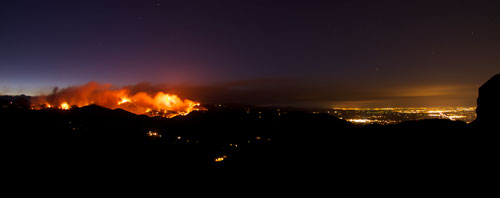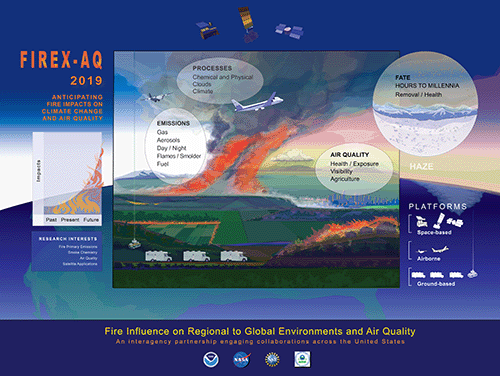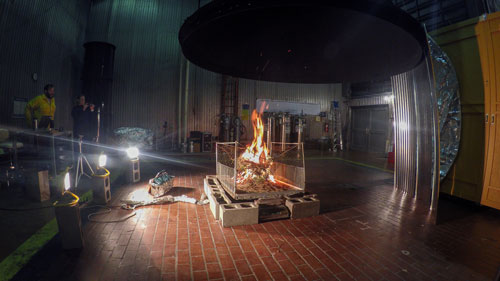A .gov website belongs to an official government organization in the United States.
A lock () or https:// means you've safely connected to the .gov website. Share sensitive information only on official, secure websites.
9 August 2018
adapted slightly from the story by CIRES Communications

When wildfires burn, they don't only damage land, homes, and businesses. Wildfire emissions, which can be transported over long distances, can be toxic and contribute to the formation of secondary pollutants such as ozone and fine particles in the atmosphere. Those emissions affect human health and the environment, so scientists want to know what's in wildfire smoke. According to new research from CIRES and NOAA, what matters most is not what kind of fuel is burning, but the temperature at which it burns.
"If we know the temperature of a fire, we can better estimate what comes out of it, independent of what's burning," said Carsten Warneke, a CIRES researcher working at CSD and a co-author on the paper, published last month in the journal Atmospheric Chemistry and Physics. "With that information, we'll be able to simplify the emissions models, better predict the downwind impacts of wildfires, and get much better forecasts for air quality."
It looks like lower-temperature fires actually produce more tiny particles called aerosols, which can get into people's lungs and mix in the atmosphere to form haze and other air pollutants downstream.

The U.S. West faces a future with more frequent and intense wildfires, according to climate projections and in part because of policies that have long encouraged fire suppression. Against that backdrop, a team of scientists from NOAA are teaming up with scientists from NASA to lead a multi-year field campaign called Fire Influence on Regional to Global Environments Experiment - and Air Quality (FIREX-AQ) to better understand the air quality and climate effects of wildfires. The new paper came out of an early FIREX investigation in 2016 in the Missoula, Montana-based Fire Lab, run by the U.S. Forest Service.
Fires produce complex emissions, releasing thousands of different volatile organic compounds (VOCs) that are often difficult to measure. Scientists initially thought wildfire emissions are mostly dependent on the type of fuel burned – for example, Douglas fir, Ponderosa pine, or sage brush. The goal of the FireLab 2016 study was to better understand emissions of vegetation burning in a simple and controlled environment. To do that, a team of NOAA and CIRES scientists ignited over 100 fires made from various fuels found in the western United States and sampled the emissions continuously with state-of-the art instruments.
The new research suggests understanding these emission patterns may be much simpler than researchers previously believed: it's the temperature of the burn and not what's burning, that's key to understanding fire emissions. Researchers could explain around 85 percent of the variability of the VOC emissions once they knew how hot a fire was: some VOCs were emitted primarily from high-temperature burns, while others were emitted from low-temperature burns. Over its course, a single fire burns at both higher and lower temperatures, releasing different VOCs at various stages. Those compounds released from low temperature burns have properties that make them more likely to form aerosols in the fire plumes.

"These results completely change the way we understand VOC emissions from wildfires," said Jim Roberts, a NOAA scientist and FIREX principal investigator. "Instead of looking at the type of fuel burned, we can focus on the temperature of the burn, something that can potentially be measured from satellites."
Those initial results from FireLab 2016 will help the NOAA researchers and their colleagues during the FIREX-AQ field campaign, slated for the 2019 fire season. The team will study the impact of western U.S. wildfires on the atmosphere and climate with the goal of developing policy-relevant information and tools to help manage fires.
As part of a newly-announced partnership, the NASA DC-8 aircraft will carry a payload of NOAA instruments, among others, on wide-ranging flights targeting western U.S. wildfires and also agricultural and prescribed burns across the southeast United States. One NOAA Twin Otter aircraft will fly over western wildfires and prescribed fires at night, sampling emissions along the way. Another NOAA Twin Otter will measure windfields feeding the fires. Mobile labs and stationary instruments will collect emission samples on the ground, and researchers will also use satellite data to help pinpoint fire temperature and track emissions on regional to global scales. And a NOAA and CIRES team will deploy an instrumented unmanned aircraft system (UAS) over some wildfires at night.
"Wildfires are one of the larger remaining issues for air quality in the United States," said Roberts. Their FIREX study could provide answers to many outstanding questions. "By doing our homework in the lab, we have identified what is in emissions and the actual process of how emissions are made," said Warneke. "Now we need to go into the field to understand real fires."
Sekimoto, K., Koss, A. R., Gilman, J. B., Selimovic, V., Coggon, M. M., Zarzana, K. J., Yuan, B., Lerner, B. M., Brown, S. S., Warneke, C., Yokelson, R. J., Roberts, J. M., and de Gouw, J., High- and low-temperature pyrolysis profiles describe volatile organic compound emissions from western US wildfire fuels, Atmospheric Chemistry and Physics, doi:10.5194/acp-18-9263-2018, 2018.
Biomass burning is a large source of volatile organic compounds (VOCs) and many other trace species to the atmosphere, which can act as precursors to secondary pollutants such as ozone and fine particles. Measurements performed with a proton-transfer-reaction time-of-flight mass spectrometer during the FIREX 2016 laboratory intensive were analyzed with positive matrix factorization (PMF), in order to understand the instantaneous variability in VOC emissions from biomass burning, and to simplify the description of these types of emissions. Despite the complexity and variability of emissions, we found that a solution including just two emission profiles, which are mass spectral representations of the relative abundances of emitted VOCs, explained on average 85% of the VOC emissions across various fuels representative of the western US (including various coniferous and chaparral fuels). In addition, the profiles were remarkably similar across almost all of the fuel types tested. For example, the correlation coefficient r2 of each profile between ponderosa pine (coniferous tree) and manzanita (chaparral) is higher than 0.84. The compositional differences between the two VOC profiles appear to be related to differences in pyrolysis processes of fuel biopolymers at high and low temperatures. These pyrolysis processes are thought to be the main source of VOC emissions. "High-temperature" and "low-temperature" pyrolysis processes do not correspond exactly to the commonly used "flaming" and "smoldering" categories as described by modified combustion efficiency (MCE). The average atmospheric properties (e.g., OH reactivity, volatility, etc) of the high- and low-temperature profiles are significantly different. We also found that the two VOC profiles can describe previously reported VOC data for laboratory and field burns.